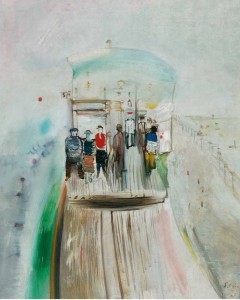In a bid to use the language of painting to describe the feeling experienced while flying on an aeroplane, Alexander Labas bought a ticket and took one of the first few Moscow – Kharkov flights. The aircraft fell into water, and it cost the two crewmembers and the three passengers, including the painter, a great deal of effort to clamber out of the sinking plane. “Previously, no one had known what a passenger would feel like during the flight, one needed to experience this,” Labas wrote in his memoirs many years later. “I felt proud that a man had been able to go up into the air, defeat Nature and put the dreams of Leonardo da Vinci into practice.” This mention of the great Italian, this reference to events of the Renaissance makes it clear what the painter of the twenties was thinking about and what his “measuring stick” was when he organizing his flight: he was thinking of the artist who, 400 years before, had also been thinking of how to enable a man to fly and had simultaneously been able to use the language of art to describe the divine and magic properties of something that made up his daily life. Labas recalled him and his discoveries because he could observe the contemporary art of painting opening up a new quality of the world. This form of art dealt with the substance that was part of a new physics of the universe. It was new art that belonged to a new world, the world that had not rejected some of the greatest achievements of the mankind.
While trying to get to the essence of the culture of the twenties. modern researches dismiss this project in Russian art as a “utopia” they mean, of course, not its political idealization of reality but the quality of the dialogue that the art was offering the society of its time and the belief that such a dialogue can exist.
Alexander Labas’s aeronautical experiments resulted in the paintings “Dirigible,” “In an Aeroplane” and “In an Aeroplane Cockpit.” “The Train,” a painting that was initially called “Travel,” has been recognized today as one of the masterpieces of the Russian art of the twenties. Their theme are people who are in movement and thereby discovering a new aspect of their existence, a new vision of what is around them, new “optics” of the world as it were.
It is essential that the artist is using a traditional cultural language — that of painting — to convey his new experience of space. Alexander Shchipitsyn followed the same deep-going artistic tradition in his works. Depicting rural life in Russia of the 1930s, he created works whose method sends us back to medieval frescoes and the masters of the early Renaissance. “Shepherd” shows a scene from everyday peasant life. But simultaneously there is an obvious motif referring it either to the Gospel story, parable or a mystery play: the woman walking into a house, the open doorway showing cold-looking darkness inside the door next to it with the animals coming out of it and the hot-looking light behind them coming from somewhere above. It seems that the visual space is hiding something behind and the entire painting can be construed as a representation of something that remains hidden — there is no “hidden meaning” there, there simply is something that is obviously hidden from us. Shchipitsyn creates a solemn and mysterious atmosphere: he invites us to look for new art’s points of contact with those meanings that are not tied down to the visible reality of his time alone.



